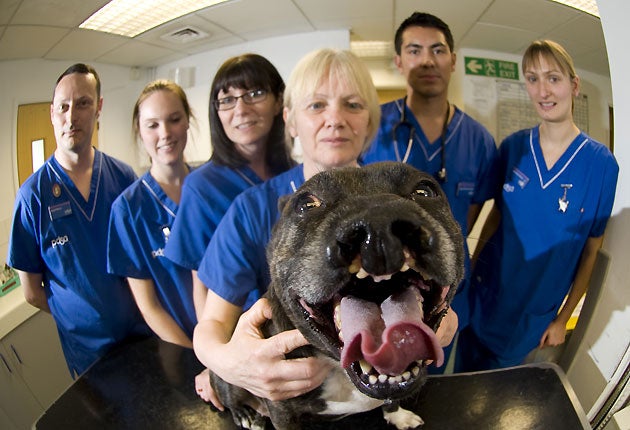Hit & Run: This show's got legs

Mrs Robinson has been through gruelling surgery which has left her unable to see out of one eye. But the facial reconstruction was a success, and given the severity of her injuries, it's a testament to the skill of her surgeons that she emerged from the operating theatre with her face intact. But she is being rather prickly about it all. Which isn't that surprising, given that Mrs Robinson is a hedgehog.
She is one of the stars of Bizarre Animal ER (10.30pm on Tue, BBC3), a series that combines the drama of the operating theatre with the sight of creatures in peril. But to make it on to the show, the animals and the accidents that befall them have to have a certain je ne sais quoi. Take, for instance, the case of Charlie the tomcat, who was plagued with urinary infections, each more serious that the last. The only solution that could cure Charlie for good was a sex change. Or how about Stumpy the four-legged duckling? Or the lizard who prolapsed when laying her eggs? Or even the trapped hamster who rescuers tried to free using a Curly Wurly as a ladder?
The programme's makers filmed in Britain's veterinary practices, animal hospitals, safari parks and zoos, charting the individual struggles of injured beasts. But what's the appeal of watching animals undergoing gory procedures? "I think it's a very British thing – we love not only animals, but stories where animals overcome adversity," explains Fiona Inskip, the series producer. "We found the stories by talking to vets. Also, lots of stories appear in local papers – they're obsessed with animal mishaps."
Mishaps is an understatement. Quentin Clarke, the series researcher, remembers once incident in particular. "We had a parakeet that was being suffocated by its own testicle. Inside was a tumour which caused the testicle to expand, pushing its lungs so much that it couldn't breathe. The tumour that the vet removed was half the parakeet's body weight." Rather than creating a freakshow of animal accidents, Inskip points to the fact-packed animations that appear throughout the show, and the amazing work done by animal carers. "We shine a light on the dedicated vets who cope with the most testing situations. In a hospital, the staff only have to treat humans – vets have to deal with every species. In the series we feature hamsters, elephants, tortoises, leopards, budgies and stick insects." And there is an unexpected bonus to the show, says Inskip. "I've learned fascinating facts to tell at dinner parties. For example, a cow produces enough dung every day to fill 70 lavatories. But it's best to save that one for after dinner." Rebecca Armstrong
Jeggings: style crime or fabulous fashion?
Calling all fashion lexicographers, there's a new sartorial phenomenon to add to your vocabulary; if not necessarily your wardrobe. Jeggings – a cross between jeans and leggings – are the latest hybrid garment/neologism to hit the high street.
They can be accurately identified by thick stretchy jersey with a denim effect print, but to be absolutely certain of a pair's authenticity, head to a changing room and try them on. If they add two stone and create an instant resemblance to Ozzy Osbourne circa 1988, you most likely have a pair of jeggings on your hands (or thighs).
Fans of the stretchy style might argue that if the curvaceous Beyonce can carry them off – she recently teamed them with a white Balmain blazer and platform shoes – then they are not only for the twig-like. However, this is a woman who is so toned she can shake her booty at 100bpm without so much as a wobble. Other hazards include VPL and baggy knee/bum syndrome, or when jeggings become beggings, if you will.
So what exactly have these strides got to offer? In fashion's pursuit of an ever skinnier stride, be it latex, leather or denim, jeggings offer maximum cling without loss of upper leg feeling or mobility. Find them in Topshop and Warehouse, which are now awash (that's a stone or snow wash) with the clingy critters. Until the next stage in the leggings' mutuation that is. Carola Long
A spell in the spotlight
Today, 50 nervous-looking children aged from nine to 15 will be on a stage in the Grand Hyatt Hotel, Washington, and try to spell antediluvian, logorrhoea and autochthonous before an audience of parents and journalists. They're semi-finalists in the Scripps National Spelling Bee, America's largest "educational promotion".
It's been going since 1925, when young Frank Neuhauser of Louisville Kentucky won by spelling gladiolus correctly. Then, it was small potatoes. Now, made popular by Jeff Blitz's 2002 documentary Spellbound, it's become a year-round epic, with regional heats, thousands of contestants and prize money totalling $32,500.
What's curious is that judges love to give contestants words of ambiguous pronunciation and watch them squirm: how they laughed at the kid who was given numnah (a sheepskin horse-blanket) and stood mortified, thinking he was being asked to spell "numbnuts". Or Andrew from North Carolina who asked the judge, again and again, to say negus as he prayed that he wasn't being given "niggers".
You could almost suspect that the spelling bee has become an exploration of middle-American taboos about certain words – and a test of how reluctant American children are to use them. John Walsh
Subscribe to Independent Premium to bookmark this article
Want to bookmark your favourite articles and stories to read or reference later? Start your Independent Premium subscription today.

Join our commenting forum
Join thought-provoking conversations, follow other Independent readers and see their replies